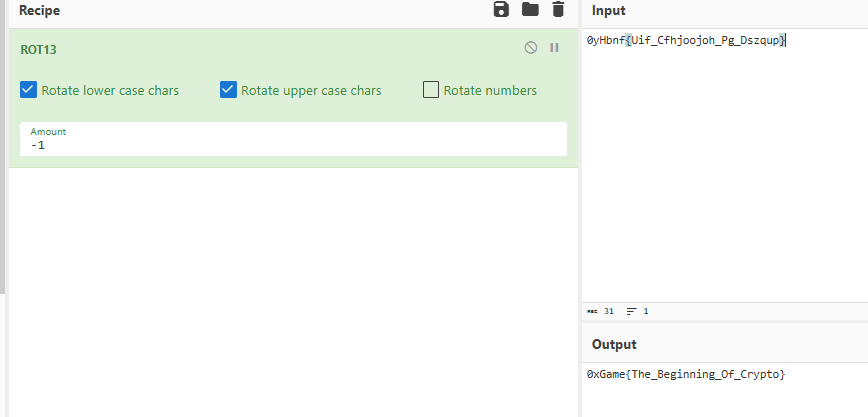0xGame2024-week1-crypto
Crypto
Caesar Cipher
密文:0yHbnf{Uif_Cfhjoojoh_Pg_Dszqup}
提示:凯撒加密。
改成-1就好了

RSA_Easy
from Crypto.Util.number import bytes_to_long, getPrime
from hashlib import md5
from random import randint
from gmpy2 import invert,gcd
#Hash Functi
on:
def MD5(m):return md5(str(m).encode()).hexdigest()
#RSA AlgorithmParameter Generation Function:
def KeyGen():
Factor_BitLength = 30
q = getPrime(Factor_BitLength)
p = getPrime(Factor_BitLength)
N = p * q
#Euler's totient function:
phi = (p-1) * (q-1)
#Generate Keys:
while True:
e = randint(1,phi)
if gcd(e,phi) == 1:
break
#Generate Result:
Pub_Key = (N,e)
return Pub_Key
Pub = KeyGen()
N = Pub[0]
e = Pub[1]
#RSA Encrypt:
m = randint(1,N)
c = pow(m,e,N)
print(f'Pub_Key = {Pub}')
print(f'Encrypt_msg = {c}')
直接网站分解就行了
from Crypto.Util.number import *
from hashlib import md5
def MD5(m):return md5(str(m).encode()).hexdigest()
Pub_Key = (689802261604270193, 620245111658678815)
Encrypt_msg = 289281498571087475
# factordb
p=823642439
q=837502087
m=pow(Encrypt_msg,inverse(Pub_Key[1],(p-1)*(q-1)),p*q)
flag = '0xGame{'+ MD5(m) +'}'
print(flag)
# 0xGame{5aa4603855d01ffdc5dcf92e0e604f31}
RSA-Baby
from Crypto.Util.number import bytes_to_long, getPrime
from hashlib import md5
from random import randint
from gmpy2 import invert,gcd
#Hash Function:
def MD5(m):return md5(str(m).encode()).hexdigest()
#RSA AlgorithmParameter Generation Function:
def KeyGen():
Factor_BitLength = 30
q = getPrime(Factor_BitLength)
p = getPrime(Factor_BitLength)
N = p * q
#Euler's totient function:
phi = (p-1) * (q-1)
#Generate Keys:
while True:
e = randint(1,phi)
if gcd(e,phi) == 1:
d = int(invert(e,phi))
break
#Generate Result:
Pub_Key = (N,e)
Prv_Key = (N,d)
return Pub_Key,Prv_Key
Pub,Prv = KeyGen()
N = Pub[0]
e = Pub[1]
d = Prv[1]
#RSA Encrypt:
m = randint(1,N)
c = pow(m,e,N)
print(f'Pub_Key = {Pub}')
print(f'Prv_Key = {Prv}')
print(f'Encrypt_msg = {c}')
给了私钥直接用就好了
from Crypto.Util.number import bytes_to_long, getPrime
from hashlib import md5
def MD5(m):return md5(str(m).encode()).hexdigest()
Pub_Key = (547938466798424179, 80644065229241095)
Prv_Key = (547938466798424179, 488474228706714247)
Encrypt_msg = 344136655393256706
m=pow(Encrypt_msg,Prv_Key[1],Pub_Key[0])
flag = '0xGame{'+ MD5(m) +'}'
print(flag)
Code
"""#How to use mathematics to represent information?
from Crypto.Util.number import bytes_to_long
from base64 import b64encode
from secret import flag
msg = flag.encode()
length = len(msg)
assert length%4 == 0
block = length//4
m = [ msg[ block*(i) : block*(i+1) ] for i in range(4) ]
m0 = m[0]
m1 = bytes_to_long(m[1])
m2 = m[2].hex()
m3 = b64encode(m[3])
print(f'm0 = {m0}\nm1 = {m1}\nm2 = {m2}\nm3 = {m3}')"""
照着敲就好了
from Crypto.Util.number import long_to_bytes
from base64 import b64decode
m0 = b'0xGame{73d7'
m1 = 60928972245886112747629873
m2 = "3165662d393339332d3034"
m3 = b'N2YwZTdjNGRlMX0='
print(m0+long_to_bytes(m1)+bytes.fromhex(m2)+b64decode(m3))
# b'0xGame{73d72f64-7656-11ef-9393-047f0e7c4de1}'
Code-Vigenere
from secret import flag
from os import urandom
from base64 import b64encode
def Encrypt(msg, key):
Lenth = len(key)
result = ''
upper_base = ord('A')
lower_base = ord('a')
KEY = [ord(key.upper()[_]) - upper_base for _ in range(Lenth)]
index = 0
for m in msg:
tmp_key = KEY[index%Lenth]
if not m.isalpha():
result += m
continue
if m.isupper():
result += chr(upper_base + (ord(m) - upper_base + tmp_key) % 26)
else:
result += chr(lower_base + (ord(m) - lower_base + tmp_key) % 26)
index += 1
return result
key = b64encode(urandom(6))[:5].decode()
print(Encrypt(flag,key))
利用密文前5个字母,配合已知flag头为0xGame可以猜测出密钥
因为最后加密模了26,所以只要在26的范围内爆破一下就好了。
后面解密就把+tmp_key改成-tmp_key就好了。
c="0lCcop{oyd94092-g8mq-4963-88b6-4helrxdhm6q7}"
m="0xGame"
key=[]
upper_base = ord('A')
lower_base = ord('a')
for i in range(1,len(m)):
for tmp_key in range(26):
if m[i].isupper():
ci = upper_base + (ord(m[i]) - upper_base + tmp_key) % 26
else:
ci = lower_base + (ord(m[i]) - lower_base + tmp_key) % 26
if ci==ord(c[i]):
key.append(tmp_key)
break
print(key)
index=0
flag=""
for m in c:
tmp_key=key[index%len(key)]
if not m.isalpha():
flag += m
continue
if m.isupper():
flag += chr(upper_base + (ord(m) - upper_base - tmp_key) % 26)
else:
flag += chr(lower_base + (ord(m) - lower_base - tmp_key) % 26)
index += 1
print(flag)
# 0xGame{acb94092-e8bc-4963-88f6-4fcadbbfb6c7}
Number-Theory-CRT
from Crypto.Util.number import bytes_to_long, getPrime
from hashlib import md5
from random import randint
from gmpy2 import invert,gcd
#Hash Function:
def MD5(m):return md5(str(m).encode()).hexdigest()
#RSA AlgorithmParameter Generation Function:
def KeyGen():
Factor_BitLength = 30
q = getPrime(Factor_BitLength)
p = getPrime(Factor_BitLength)
N = p * q
#Euler's totient function:
phi = (p-1) * (q-1)
#Generate Keys:
e = randint(1,phi)
#Generate Result:
Pub_Key = (N,e)
return Pub_Key
Pub = KeyGen()
N = Pub[0]
e = Pub[1]
#RSA Encrypt:
m = randint(1,N)
c = pow(m,e,N)
print(f'Pub_Key = {Pub}')
print(f'Encrypt_msg = {c}')
网站分解出p,q
发现e和phi不互素,gcd为2,可以直接求出\(m^2\mod n\)
之后发现p%4=3,q%4=1
对\(m^2\mod p\)使用rabin解密
然后\(m^2\mod q\)使用cipoll算法
之后枚举crt一下就好了
cipoll算法我参考的是:
https://blog.csdn.net/doyouseeman/article/details/52033204
https://unborracho.github.io/2023/04/20/二次剩余/index.html#:~:text=cipoll
from Crypto.Util.number import *
from hashlib import md5
from gmpy2 import *
from sympy.ntheory.modular import crt
def MD5(m):return md5(str(m).encode()).hexdigest()
Pub_Key = (1022053332886345327, 294200073186305890)
Encrypt_msg = 107033510346108389
# factordb
p=970868179
q=1052721013
phi=(p-1)*(q-1)
g=gcd(Pub_Key[1],phi)
gd=invert(Pub_Key[1]//g,phi)
mg=pow(Encrypt_msg,gd,Pub_Key[0])
#rabin
m1 = pow(mg, (p + 1) // 4, p)
m2 = p-pow(mg, (p + 1) // 4, p)
mp=[m1,m2]
#cipoll
def square_root_of_quadratic_residue(n, modulo):
"""Square root of quadratic residue
Solve the square root of quadratic residue using Cipolla's algorithm with Legendre symbol
Returns:
int -- if n is a quadratic residue,
return x, such that x^{2} = n (mod modulo)
otherwise, return -1
"""
if modulo == 2:
return 1
if n % modulo == 0:
return 0
Legendre = lambda n: pow(n, modulo - 1 >> 1, modulo)
if Legendre(n) == modulo - 1:
return -1
t = 0
while Legendre(t ** 2 - n) != modulo - 1:
t += 1
w = (t ** 2 - n) % modulo
return (generate_quadratic_field(w, modulo)(t, 1) ** (modulo + 1 >> 1)).x
def generate_quadratic_field(d, modulo=0):
"""Generate quadratic field number class
Returns:
class -- quadratic field number class
"""
assert (isinstance(modulo, int) and modulo >= 0)
class QuadraticFieldNumber:
def __init__(self, x, y):
self.x = x % modulo
self.y = y % modulo
def __mul__(self, another):
x = self.x * another.x + d * self.y * another.y
y = self.x * another.y + self.y * another.x
return self.__class__(x, y)
def __pow__(self, exponent):
result = self.__class__(1, 0)
if exponent:
temporary = self.__class__(self.x, self.y)
while exponent:
if exponent & 1:
result *= temporary
temporary *= temporary
exponent >>= 1
return result
def __str__(self):
return '({}, {} \\sqrt({}))'.format(self.x, self.y, d)
return QuadraticFieldNumber
mq=(square_root_of_quadratic_residue(mg,q))
mq=[mq,q-mq]
for i in mp:
for j in mq:
m=int(crt([p,q],[i,j])[0])
flag = '0xGame{'+ MD5(m) +'}'
print(m,flag)
#759871216848924391 0xGame{127016d0be858ef48a99723710ad4d49}



